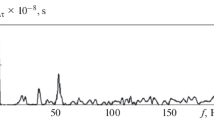Abstract
Aiming at a 300 MW turbo-generator model, the sensitivity of natural torsional frequencies and modes of torsional vibration (TV) to the rotational inertia and stiffness of the turbo-generator were analyzed. Calculation results show that the variation of the rotational inertia or stiffness either of the rotor system as a whole (namely shafting) or only locally may both remarkably influence the TV characteristics of the rotor. The influence of localized variation is still notable although it is not as great as that of the rotor as a whole. The segments on the shafting, which contribute more to a certain mode of vibration, have a greater influence on the pertaining order of TV. Compared with the modal shape, a larger slope can be observed at these sections of the rotor for the particular mode. Thus, frequencies can be modulated by modifying the local construction of the rotor to make the natural TV frequency of a certain order avoid some specific value, herewith arriving at the objective of tuning. Therefore, it is very important, in the course of modeling for the purpose of studying the TV of the shafting of a turbo-set, to accurately determine the structural parameters of parts that have a relatively sensitive effect on the TV behavior.
Similar content being viewed by others
References
Xie Danmei, Huang Juan, Wan Jianfeng, et al. Analysis on problem of removing the odd point in rotors torsional vibration characteristics’ calculation using Riccati method. In: Proceedings of 2003 International Conference of Machine Learning and Cybernetics, 2003, 2185–2188
Sun Hetai. Approach to torsional vibration of shaft system for high capacity. Thermal Power Generation, 2004, (1): 42–44 (in Chinese)
Liu Yingzhe, Fu Xingjun. Torsional Vibration of Steam Turbine Generator Units. Beijing: China Electric Power Press, 1997 (in Chinese)
Munsi A S, Waddell A J, Walker C A. Vibratory stress relief-an investigation of the torsional stress effect in welded shafts. Journal of Strain Analysis, 2001, 36(5): 453–464
Wang Qi. Torsional Vibration of Internal Combustion Engine. Beijing: Press of National Defense Industry, 1985 (in Chinese)
Ramey D G, Sismour A C, Kung G C. Important parameters in considering transient torques on turbine2generator shaft systems. IEEE Transactions on Power Apparatus and Systems, 1980, 99(1): 311–317
Walker D N, Adams S L, Placek R. Torsional vibration and fatigue of turbine generator shafts. IEEE Transactions on Power Apparatus and Systems, 1981, 100(11): 4373–4380
Feng Zhimin, Wang Ying, Lang Haoxiang. Research on the faults mechanics of rotors’ torsional vibration and their prevention. Marine Engineering, 2002, (2): 5–9 (in Chinese)
Milanovic J V, Smiee S, Fu C P N, et al. Sensitivity of torsional modes and torques to uncertainty in shaft mechanical parameters. Electric Power Components and System, 2001, 867–881
Author information
Authors and Affiliations
Corresponding author
Additional information
__________
Translated from Journal of Power Engineering, 2005, 25(4): 462–465, 482 [译自: 动力工程]
Rights and permissions
About this article
Cite this article
Xie, D., Liu, Z., Zhang, H. et al. Sensitivity analysis of torsional vibration behavior of the shafting of a turbo generator set to changes of its mechanical parameters. Front. Energy Power Eng. China 1, 483–486 (2007). https://doi.org/10.1007/s11708-007-0072-4
Issue Date:
DOI: https://doi.org/10.1007/s11708-007-0072-4




